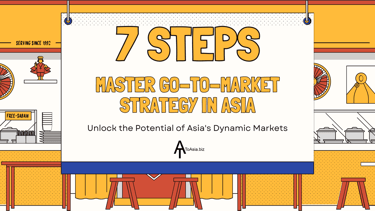7 Steps to Master Your Go-To-Market Strategy in Asia
BUSINESS TIPS
Alan Wong
7/19/202411 min read


Are you ready to conquer the world's most dynamic and fastest-growing markets?
Asia is calling, and your go-to-market (GTM) strategy holds the key to success.
As the founder of an Asian business consultancy, I've seen countless companies stumble and soar in these complex markets.
Today, I'm sharing the blueprint that has helped our clients achieve remarkable success.
Let's dive into the 7 steps that will transform your Asian market entry from a daunting challenge into a triumphant journey.
Conclusion: Your Roadmap to Asian Market Success
Mastering your Go-to-Market strategy in Asia is an ongoing journey of learning, adaptation, and growth.
By following these 7 steps and considering the product lifecycle stages, you're well-equipped to navigate the complexities and seize the immense opportunities in Asian markets.
Remember, success in Asia isn't just about having the right product—it's about having the right approach, the right partners, and the flexibility to evolve with these dynamic markets.
Are you ready to take on the exciting challenge of expanding into Asia?
What's your first step going to be?
At ToAsia.biz, we understand that navigating the Asia Pacific digital market presents unique challenges and opportunities.
Our approach combines local expertise with a focus on sustainable growth, helping businesses develop tailored business plans and strategies for diverse Asian markets, navigate region-specific platforms and regulations, and identify and capitalize on emerging trends.
By embracing a test-and-learn mindset and staying agile in the face of change, businesses can turn the complexities of the digital landscape into opportunities for business growth.
We as your partner, you'll be well-equipped to adapt, innovate, and thrive in the dynamic digital ecosystem of the Asia Pacific region.
Our commitment to helping you expand at the right pace while maintaining lean operations and profitability sets us apart, ensuring that your digital marketing efforts not only reach new heights but also contribute to sustainable, long-term success in this vibrant and opportunity-rich market.
Talk to us today and discover how our approach sets us apart from other business consultants.


Go-To-Market Step 1: Conduct Comprehensive Market Research
The first step in mastering your GTM strategy in Asia is to truly understand the market landscape.
This isn't just about numbers; it's about uncovering the soul of each market you're targeting.
Segment strategically
Asian markets are incredibly diverse.
What works in Tokyo might flop in Jakarta.
Divide your target markets based on factors like:
Economic development. Consider the vast differences between developed markets like Singapore and emerging ones like Vietnam.
Cultural values. Understand the impact of Confucian values in East Asia versus the influence of Islam in Southeast Asian countries like Indonesia and Malaysia.
Consumer behavior. Recognize how urbanization in China leads to different consumer habits compared to rural India.
Technology adoption rates. Note the high AI penetration in Singapore and South Korea.
Identify your ideal customer
Who's your Asian counterpart to your home market customer?
They might surprise you. Use a mix of:
Demographic data: Consider the young population in countries like the Philippines versus the aging population in Japan.
Psychographic insights: Understand the growing middle class in India and their aspirations.
Behavioral analysis: Study the preference for mobile payments in China versus cash transactions in other parts of Asia.
Analyze local consumer behavior
Shopping habits: Explore the popularity of night markets in Taiwan or the prevalence of convenience stores in Japan.
Brand preferences: Understand the balance between international brand prestige and local brand loyalty across different Asian markets.
Decision-making processes: Consider the importance of family opinions in purchase decisions in many Asian cultures.
Influence of social networks: Recognize the power of platforms like WeChat in China or Line in Japan for brand recommendations.


Go-To-Market Step 3: Develop a Customized Pricing Strategy
Pricing can make or break your success in Asia.
It's a delicate balance between perceived value, local purchasing power, and competitive positioning.
Factors influencing pricing in Asian markets:
Local income levels: Consider the vast disparity between high-income markets like Singapore and emerging economies like Cambodia.
Competitor pricing: Study both local and international competitor prices in each market.
Perceived brand value: Understand how your brand is positioned compared to local favorites and other international brands.
Import taxes and duties: Factor in additional costs for imported goods, which can significantly impact final pricing.
Value-based pricing approaches:
Focus on unique benefits: Highlight how your product solves specific local problems or fulfills unique needs.
Highlight quality and innovation: Emphasize technological advancements or superior materials, especially in markets like Japan or South Korea that value cutting-edge products.
Leverage brand reputation: Use your global brand status in markets that value international prestige, but be prepared to build your reputation from scratch in others.
Competitive pricing analysis:
Monitor local and international competitors: Keep track of both global brands and strong local players in each market.
Understand price sensitivity: Recognize that consumers in markets like India might be more price-sensitive than those in Japan.
Consider promotional strategies: Explore the effectiveness of discounts during major shopping festivals like Singles' Day in China or Diwali in India.


Go-To-Market Step 2: Localize Your Product or Service
Localization goes far beyond translation.
It's about making your offering feel like it was created specifically for each Asian market.
Adapt to local preferences:
Adjust flavors: Consider creating durian-flavored products for Southeast Asian markets or matcha variations for Japan.
Resize products: Offer smaller portions or packaging in densely populated urban areas with limited storage space in Hong Kong.
Align with local lifestyle habits: Develop products that cater to the "work hard, play hard" culture in cities like Tokyo or Singapore.
Address cultural sensitivities:
Be aware of religious considerations: Ensure halal certification for food products in Muslim-majority countries like Indonesia or Malaysia.
Understand local taboos: Avoid the number 4 in product lines or floor numbers in East Asian countries due to its association with death.
Respect traditional values: Incorporate elements of filial piety in marketing campaigns for products aimed at older demographics.
Localization case study:
McDonald's localization strategy success in India came from creating a menu that catered to vegetarian preferences and local tastes, like the McAloo Tikki burger.


Go-To-Market Step 4: Optimize Distribution Channels
In Asia, your distribution strategy can be as crucial as your product itself.
The right channels can make your product accessible and desirable.
E-commerce and mobile platforms:
Leverage local giants: Partner with platforms like Alibaba or JD.com in China, Shopee or Lazada in Southeast Asia, or Rakuten in Japan.
Optimize for mobile-first consumers: Ensure your online presence is fully mobile-optimized, especially in markets like Indonesia where mobile internet usage dominates.
Integrate with popular payment systems: Offer options like WeChat Pay and Alipay in China, Paytm in India, or GrabPay in Southeast Asia.
Traditional vs. modern trade:
Balance between traditional markets and modern retail: Recognize the importance of wet markets in countries like Vietnam alongside modern supermarkets.
Understand the role of wholesalers and distributors: Navigate complex distribution networks, especially in countries with challenging geographies like Indonesia or the Philippines.
Consider the importance of convenience stores: Recognize their significance in countries like Japan, South Korea, and Thailand for everyday purchases and even as pick-up points for online orders.
Strategic partnerships and local collaborations:
Join forces with established local players: Consider joint ventures or partnerships to navigate complex markets like India or China.
Explore licensing or franchising opportunities: This can be particularly effective in markets with strong local business networks, like South Korea or Japan.
Leverage local influencers and KOLs (Key Opinion Leaders): Collaborate with popular figures on platforms like Xiaohongshu (Little Red Book) in China or Instagram in Southeast Asia.


Go-To-Market Step 5: Craft a Culturally Relevant Marketing Strategy
Your marketing strategy needs to speak the local language—not just linguistically, but culturally.
Leverage local social media platforms:
Master platforms like WeChat in China, Line in Thailand, or Kakao Talk in South Korea.
Understand the nuances of each platform's user behavior: For example, the preference for short-form video content on Douyin (TikTok) in China.
Create platform-specific content strategies: Develop interactive H5 pages for WeChat or engaging AR filters for Instagram in markets like Indonesia or the Philippines.
Influencer marketing in Asia:
Identify and partner with relevant KOLs: Work with tech reviewers in gadget-loving markets like South Korea or beauty influencers in image-conscious societies like Japan.
Understand the power of micro-influencers: Leverage their high engagement rates in niche markets or specific cities.
Create authentic collaborations: Develop long-term partnerships that resonate with local audiences, respecting the strong parasocial relationships between influencers and followers in many Asian countries.
Content localization and translation:
Go beyond literal translation: Adapt your message to local cultural contexts, considering factors like collectivism vs. individualism in different Asian societies.
Adapt idioms, humor, and cultural references: Use local proverbs or pop culture references that resonate in each market.
Use local imagery and scenarios in visual content: Feature local landmarks, traditional clothing, or typical local scenarios in your marketing materials.


Go-To-Market Step 6: Build a Strong Sales Team and Process
Your team on the ground can make all the difference in Asian markets.
Recruiting and training local talent:
Hire for cultural fit and market understanding: Look for team members who can navigate local business etiquette and understand consumer psychology in each market.
Invest in continuous training: Keep your team updated on both product knowledge and evolving local market dynamics.
Foster a blend of local insights and global brand vision: Create a team culture that values both local expertise and alignment with your global brand values.
Adapting sales techniques to Asian business culture:
Understand the importance of relationship-building: Recognize the value of "guanxi" in China or "nemawashi" in Japan for building business relationships.
Respect hierarchies and decision-making processes: Be patient with the collective decision-making processes common in many Asian businesses.
Be patient: Understand that deals often take longer to close in Asia due to the emphasis on building trust and consensus.
Implementing effective CRM systems:
Choose systems that can handle local languages and currencies: Ensure your CRM can process multiple Asian languages and currencies efficiently.
Integrate with local platforms: Connect your CRM with popular messaging apps like WhatsApp or Line for seamless communication.
Ensure compliance with local data protection laws: Be aware of regulations like China's Cybersecurity Law or Singapore's Personal Data Protection Act.


Go-To-Market Step 7: Establish Performance Metrics and Feedback Loops
Success in Asia requires constant adaptation and improvement.
Key performance indicators for Asian markets:
Set realistic, market-specific targets: Understand that growth rates and market share expectations may differ vastly between mature markets like Japan and emerging ones like Vietnam.
Monitor both quantitative and qualitative metrics: Track sales and market share, but also brand perception and customer satisfaction through local review sites and social media.
Track social media sentiment: Use local social listening tools to monitor brand mentions and sentiment on platforms like Weibo in China or Naver in South Korea.
Continuous improvement strategies:
Regular market research: Conduct frequent surveys and focus groups to stay attuned to rapidly changing consumer preferences in dynamic Asian markets.
Competitor analysis: Keep a close eye on both local champions and other international brands in your space.
Agile product development: Be prepared to quickly adapt products or services based on local feedback, considering the fast-paced nature of many Asian markets.
Adapting to market feedback:
Be prepared to pivot quickly: Asian consumers often expect rapid responses to feedback and swift product iterations.
Create systems for rapid adjustments: Develop processes that allow for quick product modifications or marketing message changes.
Foster a culture of learning: Encourage your Asian teams to share insights and best practices across different markets.


Tailoring Your GTM Strategy Across Product Lifecycle Stages in Asia
Remember, your GTM strategy isn't static.
It needs to evolve as your product moves through its lifecycle in Asian markets.
Introduction Stage
Identify early adopters and Create awareness:
Leverage social media to create buzz, particularly on platforms popular with younger demographics like Instagram, TikTok in Southeast Asia and Threads in Taiwan
Invest heavily in education and brand storytelling, considering the importance of brand heritage in many Asian markets.
Use influencers to demonstrate product benefits, leveraging their strong impact on consumer decisions in countries like China and South Korea.
Penetration pricing:
Consider lower initial pricing to encourage trial, especially in price-sensitive markets like India or Indonesia.
Offer exclusive launch promotions to create urgency, tapping into the fear of missing out (FOMO) prevalent in many Asian consumer cultures.
Growth Stage
Expand to broader segments:
Move beyond early adopters to the mass market, considering the vast middle class in countries like China and India.
Tailor messaging for different customer segments, recognizing the diversity within each Asian market.
Scale marketing efforts:
Increase advertising spend across diverse channels, balancing traditional media (still important in markets like Japan) with digital platforms.
Expand distribution to reach more consumers, potentially moving from tier-1 cities to tier-2 and -3 cities in large markets like China.
Adapt distribution:
Partner with larger retailers or e-commerce platforms, such as Alibaba in China or Shopee in Southeast Asia.
Consider local manufacturing to reduce costs and improve supply chain efficiency, especially in markets with high import duties.


Maturity Stage
Focus on customer retention:
Implement loyalty programs tailored to local preferences, such as social sharing rewards in China or family-oriented benefits in Southeast Asia.
Provide exceptional after-sales service, recognizing its importance in markets like Japan where customer service expectations are extremely high.
Product improvements:
Regularly update features based on local feedback, staying ahead of fast-moving trends in markets like South Korea.
Consider line extensions to cater to specific Asian market needs, such as smaller portion sizes for aging populations in Japan or larger family packs in India.
Value-based pricing:
Shift focus from price to value proposition, emphasizing quality and brand prestige, particularly effective in status-conscious markets like China.
Highlight unique benefits over competitors, addressing specific local pain points or aspirations.
Saturation Stage
Identify niche opportunities:
Look for underserved segments within saturated markets, such as the growing elderly population in Japan or the rising affluent class in Vietnam.
Consider expanding to second-tier cities or rural areas, especially in large countries like China or India where these markets are increasingly important.
Innovate to differentiate:
Invest in R&D to stay ahead of local competitors, particularly important in tech-savvy markets like South Korea or Taiwan.
Collaborate with local tech companies or startups for fresh ideas, tapping into the vibrant innovation ecosystems in hubs like Shenzhen or Singapore.
Optimize costs:
Streamline operations without compromising quality, crucial in markets where consumers expect high quality at competitive prices.
Consider local sourcing to reduce costs, potentially setting up regional hubs in countries like Vietnam or Malaysia.
Decline Stage
Strategize for market exit or product discontinuation:
Plan a graceful exit that maintains brand reputation, crucial in relationship-oriented Asian business cultures.
Consider selling to a local competitor or pivoting to a new product line, potentially leveraging your brand strength in adjacent categories.
Explore new opportunities:
Look for emerging markets within Asia, such as frontier markets like Vietnam or Malaysia.
Consider how your product could be repurposed for different uses or markets, adapting to local needs and preferences.
Manage brand reputation:
Communicate transparently with customers and partners, respecting the importance of long-term relationships in Asian business cultures.
Ensure proper support for existing customers during transition, maintaining trust and potentially opening doors for future re-entry or new product launches.


Go-To-Market Strategy vs. Business Strategy: What's the Difference?
Confused about Go-To-Market (GTM) Strategy and Business Strategy? You're not alone. Let's break it down, Asian-style:
Business Strategy: The big picture
Your company's long-term game plan
Sets overall direction and goals
Example: "We'll conquer Southeast Asia in 10 years!"
GTM Strategy: The action plan
Focuses on launching specific products/services
Detailed, tactical, and market-specific
Example: "Here's how we'll make Vietnamese consumers love our bubble tea next month!"
Think of it this way:
Business Strategy asks: "Should we enter Asia? Which markets?"
GTM Strategy answers: "How do we win in Vietnam... right now?"
Remember: A solid Business Strategy points you towards Asia.
A killer GTM Strategy ensures you don't get lost in translation!


Alan Wong is founder of ToAsia.biz and a startup mentor with over 20 years of professional experience managing software, Saas and consulting services MNCs.
About Author
Copyright © 2025 ToAsia.biz


We lead your business to Asia
Our Business Growth Experts help SaaS businesses achieve growth in Asia and become profitable FAST.
Send us a message via WhatsApp
